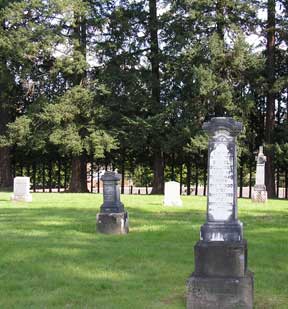 |
Previous Issues |
| Cedar Mill Community Website |
|
| About Cedar Mill News |
|
||||||
| Volume 7, Issue 3 | March 2009 |
|||||
History in the News
|
 |
| St. Anthony of Padua cemetery |
In 1876, Archbishop Frances Blanchet appointed Father Joseph Edward Hermann, a German-born priest, to serve all of Washington County. He selected the Cedar Mill area for a new church, later writing, “This place was and is the most central location of the Catholic settlers in that section” of Washington County.
Planning for a church was started in 1878. It was built by 1880 near Murray Road but was moved across the street in 1882 because of a change in the county road, and to provide a burial ground for the Catholics of eastern Washington County. This cemetery, “The Catholic Pioneer Cemetery of St. Anthony of Padua,” still exists today north of the present Village Baptist Church on Murray Blvd.
A school for the new parish was built in 1888 and was staffed by the Dominican sisters. Tuition was $1 per month. There was a time that the school was without sisters, and then it reopened in 1895 with the Sisters of Mercy from New Zealand. A convent was soon built. In 1897 both the school and the convent burned down. Two years later, they were both rebuilt only to have the school burn down again in 1906.
 |
| St. Anthony of Padua Catholic Church confirmation class, May 19, 1900. Photo courtesy of Mary Groch |
In 1893 the city of Beaverton was incorporated. In 1903 Archbishop Alexander Christie purchased land for a new church in Beaverton. By that time, a lot of the population had moved from Cedar Mill to Beaverton due to the railroad. The first Mass was said there in 1908 in a converted cheese factory. It was dedicated to St. Mary and Mass was said weekly. In 1913 a combination church and school was built. St. Cecilia church, school and rectory were on the site of the present Damerow Ford on Canyon Road and Hall Blvd. in Beaverton.
Masses continued to be said at St. Anthony’s on the last Sunday of the month until 1917. After the rectory burned in 1915, Fr. James O’Flynn lived in Beaverton and traveled by horseback to St. Anthony’s to say Mass. Only the cemetery and a row of redwood trees planted by the sisters remain near the site of the old parish on Murray Blvd.
An old St. Anthony of Padua Parish register that dates to 1876 lists many names that we will recognize today. Members included Thomas and Ann Leahy from County Waterford, Ireland, and Owen Murray who came to Oregon from San Francisco, and members of the Barnes and Teufel families.
Next month we’ll bring the history of the Catholic Church in Cedar Mill up-to-date with information about the founding and development of St. Pius X.
Published monthly by Cedar Mill Advertising & Design
Publisher/Editor:Virginia Bruce
503-629-5799
PO Box 91061
Portland, Oregon 97291